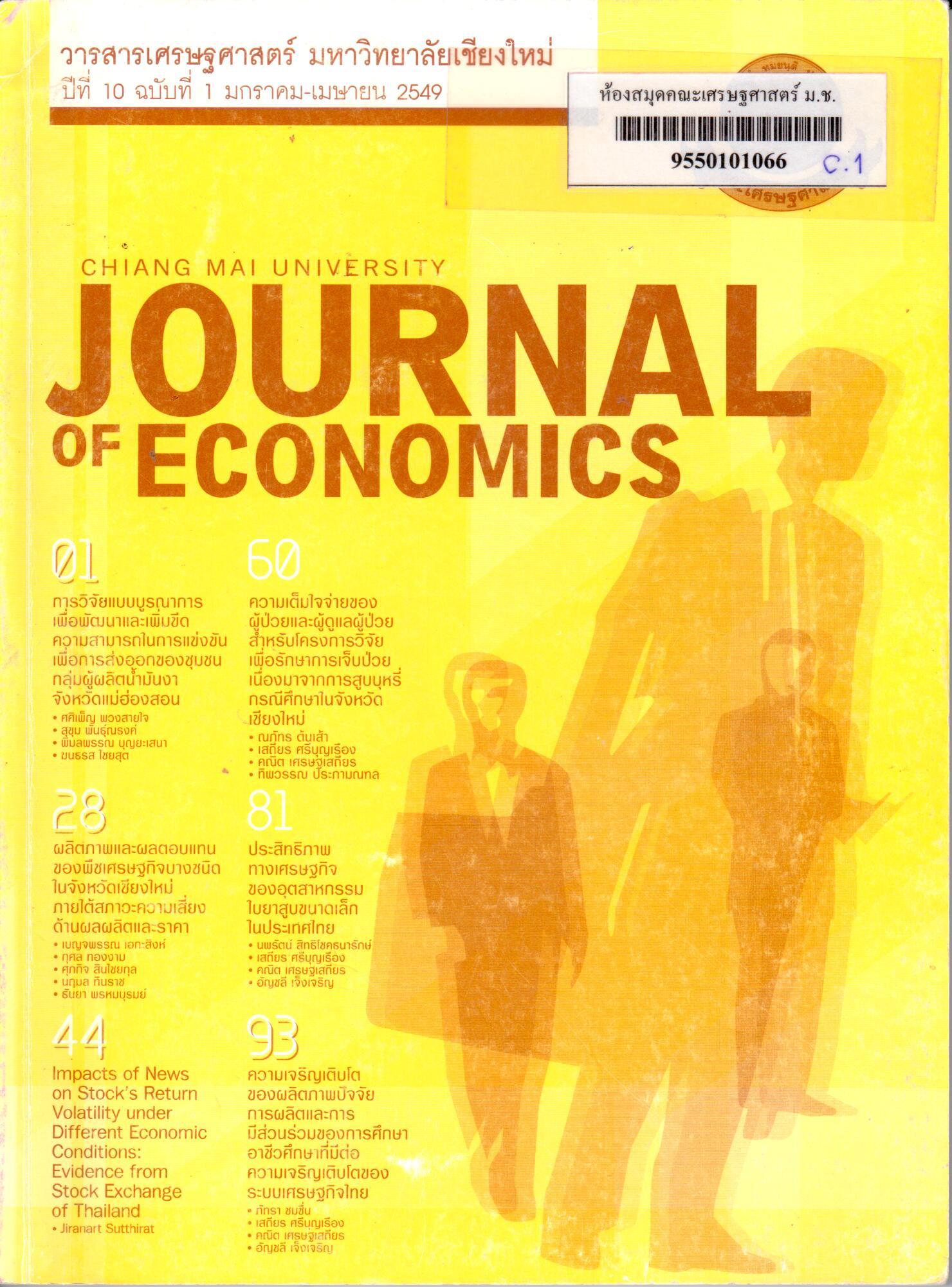การวิเคราะห์โครงการการจ่ายไฟให้หมู่บ้านห่างไกลด้วยพลังงานทดแทน
Abstract
บทคัดย่อ
การศึกษาการวิเคราะห์โครงการจ่ายไฟให้หมู่บ้านห่างไกลด้วยพลังงานทดแทนมีวัตถุประสงค์ 4 ประการ คือ (1) ศึกษาข้อมูลทั่วไปในระดับครัวเรือนและระดับหมู่บ้านในพื้นที่ (2) พยากรณ์ความต้องการใช้ไฟฟ้า (3) ศึกษาทางเลือกที่เหมาะสมทางด้านเศรษฐศาสตร์และการเงิน (4) จัดทำแผนแม่บททางด้านเศรษฐศาสตร์และการเงิน
ในการศึกษาได้พิจารณาระบบสายไฟ 4 ระบบได้แก่ระบบ Solar Home System (SHS), ระบบ Hydro Micro-Grid, ระบบ PV Micro-Grid และระบบ PV/Hydro Micro-Grid ส่วนการสำรวจข้อมูลในระดับครัวเรือน ใช้วิธีการสุ่มตัวอย่างแบบง่าย โดยการสัมภาษณ์ประชาชน หมู่บ้านละ 11 ครัวเรือน รวมทั้งสิ้น 6,138 ครัวเรือน ผลการศึกษาพบว่าเกือบร้อยละ 90 ของหมู่บ้านทั้งหมดประกอบด้วยชาวไทยภูเขาเผ่าต่างๆ ประชากรร้อยละ 90.63 ประกอบอาชีพเกษตรกรรม รายได้เฉลี่ยต่อครัวเรือนคือ 20,760 บาทต่อปี มีรายจ่ายค่าพลังงานโดยเฉลี่ยประมาณ 3,000 บาทต่อปี เป็นค่าเทียนไข น้ำมันก๊าดและถ่านไฟฉาย
เกณฑ์การเลือกระบบการจ่ายไฟที่เหมาะสมพิจารณาจากศักยภาพด้านต่างๆและอัตราผลตอบแทนภายในทางเศรษฐศาสตร์ (EIRR) โดยในแผนแม่บท แบ่งเป็น 2 ระยะเฟสการลงทุน หมู่บ้านที่มีคะแนนศักยภาพมากกว่า 60 % เป็นหมู่บ้านในเฟสที่ 1 ของการลงทุน ส่วนหมู่บ้านที่เหลือจะอยู่ในเฟสที่ 2 สำหรับเฟสที่ 1 มีจำนวน 338 หมู่บ้าน ใช้เงินทุนเริ่มแรกประมาณ 472,642,700 บาท หมู่บ้านที่เหมาะสมกับการติดตั้งระบบ SHS มีจำนวน 287 หมู่บ้าน ซึ่งมากที่สุดเมื่อเปรียบเทียบกับระบบอื่นๆ สำหรับเฟสที่ 2 ของการลงทุน มีจำนวน 220 หมู่บ้าน และใช้เงินลงทุนเริ่มแรกประมาณ 310,097,100 บาท หมู่บ้านที่เหมาะสมกับการติดตั้งระบบ SHS จำนวน 194 หมู่บ้าน ซึ่งมากที่สุดเมื่อเปรียบเทียบกับระบบอื่นๆเช่นกัน
จากการสำรวจพบว่าหมู่บ้านที่มีน้ำตก 224 หมู่บ้าน แต่ระบบจ่ายไฟพลังน้ำเป็นทางเลือกมีความเหมาะสมคิดเป็นประมาณร้อยละ 9 เท่านั้น สาเหตุจากค่าดูแลบำรุงรักษาระบบไฟฟ้า และอัตราภาษีนำเข้าของอุปกรณ์ระบบจ่ายไฟพลังทดแทนมีค่าสูง จึงมีผลลบต่อค่า EIRR ดังนั้นในการจัดทำแผนบท ได้ทำการวิเคราะห์ความอ่อนไหว ในกรณีที่ค่าดูแลและบำรุงรักษาลดลงจากร้อยละ 15 เป็นร้อยละ 10 และ 5 ตามลำดับ ในกรณีที่อัตราภาษีลดลงร้อยละ 50 และไม่มีอัตราภาษีเลย ผลทำให้ระบบ Hydro มีค่า EIRR สูงขึ้น และทำให้จำนวนหมู่บ้านที่มีความเหมาะสมที่จะติดตั้งระบบ Hydro มีจำนวนมากขึ้นตาม
Abstract
The objectives of feasibility study on renewable energy electrification for remote villages are: (1) to review and examine baseline socio-economic data in 558 remotes villages, (2) to forecast electricity demand, (3) to analyze financial and economic feasibility study, and (4) to undertake and implement master plan for renewable energy electrification in those remote villages.
In this study, Solar Home System (SHS), Hydro Micro-Grid, PV Micro-Grid, and PV/Hydro Micro-Grid system are considered as the renewable energy electrification in remote villages. The baseline socio-economic data survey of 11 households in each village, totally 6,138 observations are collected by Simple Random Sampling technique, and conducted by interviewing method using questionnaire forms. The results reveal that nearly 90% of those remote villages are hill tribes. Most of them are farmers and have income per capita of 20,760 Baht/year. Their energy spending in candle, gasoline and dry battery are about 3,000 Baht/year.
The criterion for choosing and appropriate system to install the renewable electrification in each remote village is considered by the available resources for producing electricity, potential in operating and maintenance the system, and the Economic Internal Rate of Return (EIRR) in that village. A village with score greater than 60% is classified in the first phase of the implementation plan. The rest are grouped and implemented in phase 2. As for the first phase, it covers 338 villages with the approximately initial investment of 472,642,700 Baht. The SHS is an appropriate system for 287 villages, which have the highest portion relative to other systems. As for the second phase, it covers 220 villages with the approximately initial investment of 310,097,100 Baht. The SHS is a proper system for 194 villages and still has the highest portion relative to other systems.
In addition, it is found that 224 villages have waterfall but the Hydro system option is selected for only 9%. The obstacle factors for choosing Hydro system are high cost of operating and maintenance, and high import tax rate of renewable energy system equipments which affect on rate of return investment. As a result, the study of master plan analyzes the project sensitivity to the operating and maintenance cost by reducing from 15% to 10% and 5%, respectively. Also, the sensitivity to import tax by reducing to 50% of the previous and 0% tax rate are analyzed. The results exhibit that the EIRR of Hydro system is increased significantly and the numbers of villages are feasible to install Hydro system is also increased.Downloads
Issue
Section
License
All opinions and contents in the CMJE are the responsibility of the author(s). Chiang Mai University Journal of Economics reserves the copyright for all published materials. Papers may not be reproduced in any form without the written permission from Chiang Mai University Journal of Economics.
ข้อคิดเห็นที่ปรากฏและแสดงในเนื้อหาบทความต่างๆในวารสารเศรษฐศาสตร์มหาวิทยาลัยเชียงใหม่ ถือเป็นความเห็นและความรับผิดชอบโดยตรงของผู้เขียนบทความนั้นๆ มิใช่เป็นความเห็นและความรับผิดชอบใดๆของวารสารเศรษฐศาสตร์ มหาวิทยาลัยเชียงใหม่
บทความ เนื้อหา และข้อมูล ฯลฯ ในวารสารเศรษฐศาสตร์มหาวิทยาลัยเชียงใหม่ ถือเป็นลิขสิทธิ์เฉพาะของคณะเศรษฐศาสตร์มหาวิทยาลัยเชียงใหม่ หากบุคคลหรือหน่วยงานใดต้องการนำทั้งหมดหรือส่วนหนึ่งส่วนใดไปเผยแพร่ต่อหรือเพื่อกระทำการใดๆ จะต้องได้รับอนุญาตเป็นลายลักษณ์อักษร จากวารสารเศรษฐศาสตร์ มหาวิทยาลัยเชียงใหม่






